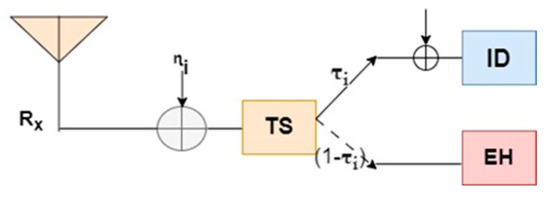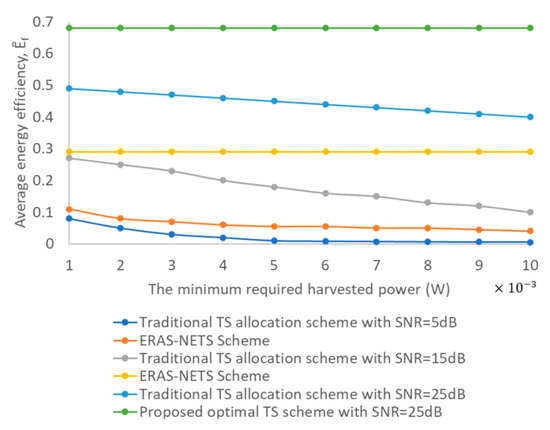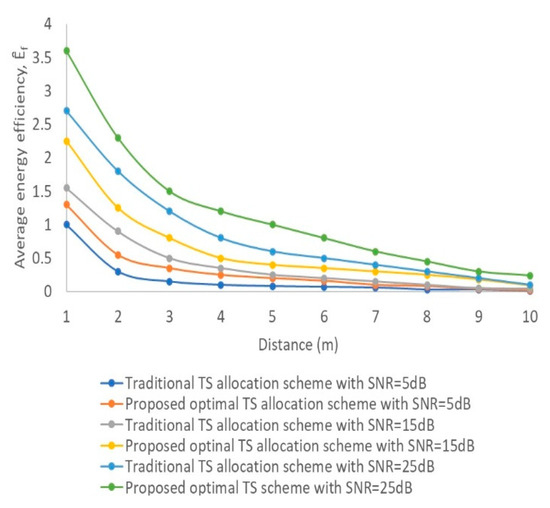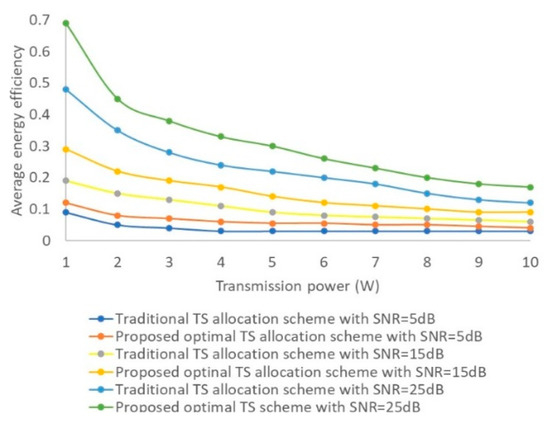Abstract
This paper presents an optimal resource allocation scheme based on time slot switching (TS) for point-to-point single-input single-output (SISO) simultaneous wireless information and power transfer (SWIPT) systems, aiming to maximize the average achievable rate. The proposed scheme considers the nonlinear energy harvesting (EH) characteristic, and thus, the problem is formulated as a nonconvex optimization problem in the presence of a binary TS ratio. Hence, solving the problem is performed using the time-sharing strong duality theorem and Lagrange dual method. Simulations showed that the proposed scheme improves energy efficiency with respect to different transmission powers by 20%, 10%, and 3% for high-SNR, medium-SNR, and low-SNR regions, respectively. Improvement with respect to average energy efficiency versus other system performance metrics has also been noted for the proposed scheme.
1. Introduction
Energy shortage is considered as one of the main issues faced by energy-constrained wireless networks [1]; hence, energy shortage directly affects the network lifetime and performance. Energy harvesting (EH) becomes a promising solution for reducing energy consumption and extending the lifetime of energy-constrained wireless networks where nodes harvest energy from the surrounding environment. The simultaneous wireless information and power transfer (SWIPT) is one of the EH technologies, where energy harvesting is performed through the radio frequency (RF) signals since RF signals are able to carry both information and electromagnetic energy simultaneously. Thus, SWIPT is currently an area of high research interests due to its higher efficiency compared to that of information and power transmission with orthogonal resources, i.e., time or frequency channels [2]. Authors of [3,4] present a trade-off between the amount of harvested energy and the achievable rate for the SWIPT systems in the frequency selection channel with additive white Gaussian noise (AWGN). TS and power splitting (PS) SWIPT receivers were first proposed in [5], and since then, the idea of using TS and PS SWIPT receivers has been adopted in the literature. Authors of [6] present multiuser single-input single-output (SISO) orthogonal frequency-division multiplexing (OFDM) system where the TS and PS ratios are optimized to maximize the weighted sum rate of all receivers. Authors of [7] propose an energy efficiency maximization optimization scheme for the multiuser multicarrier energy-constrained amplify-and-forward (AF) multi-relay network. Aiming at minimizing the transmission power, the power allocation problem for the multiuser system is studied, and the optimal PS ratio is obtained in [8]. Power allocation and subcarrier allocation schemes are presented in [9,10] for energy-efficient, large-scale, multiple-antenna SWIPT systems. Most of the proposed SWIPT systems in the literature consider the linear EH model, where the power conversion efficiency factor of the EH receiver is assumed to be constant. However, this assumption was rejected by [11], after showing the saturation behavior of the output power of the RF to direct current converter as the input power exceeds a certain threshold. In [12,13,14], a nonlinear EH model is presented to optimize the power split factor to minimize the outage probability for the AF relay system with the PS receiver. In this paper, an SISO point-to-point SWIPT communication system with TS receiver is considered where the nonlinear saturation input–output characteristic of EH circuit is modeled, and a simple optimal resource allocation scheme based on the time slot-switching strategy to maximize the average achievable rate for the system is proposed. The main contribution of this paper is the consideration of the effect of the saturation characteristic of the nonlinear EH model, and the achievable rate in the TS SWIPT system is mathematically formulated where the scheme shows the regions that the receiver can use to harvest energy or decode information based on the value of SNR. Another contribution is that the proposed resource allocation scheme maximizes the network energy efficiency.
2. System Model
We consider an SISO point-to-point SWIPT communication system as shown in Figure 1, where both the receiver and the transmitter have single antenna and Rx is assumed to be energy limited and can harvest energy from the received signals with a TS scheme. The channel between the transmitter and the receiver is subjected to frequency flat and the block Rayleigh fading. The channel coefficient is denoted as h, which is a random variable following the complex Gaussian distribution with zero mean and variance σ2. The optimal problem is formulated as a nonconvex optimization, which we have proved meets the time-sharing condition, and then, the problem is solved by using the time-sharing strong duality theorem and Lagrange dual method. Without the loss of generality, we assume that each time slot is normalized transmission time. In each time slot, the TS ratio Ԏ is equal to 0 or 1, indicating that the receiver implements EH or ID operations, respectively. The received signal SR is provided in Equation (1) and is as follows:
where Pt is the transmit power, x is the data symbol with unity power, i.e., where E[] is the mathematical expectation, ~ CN (0, σ2) is the channel noise, = d−m represents the path loss, d is the distance between the source and the destination nodes, and m represents the pathloss exponent. The achievable rate ℜ of the system based on the TS scheme is provided in Equation (2) and is as follows:
where H = h2 is the channel power gain.

Figure 1.
The SISO point-to-point SWIPT system.
We use the piece-wise linear function to model the nonlinear saturation input–output characteristic of the EH receiver. The harvested power at the EH receiver is provided by Equation (3) and is as follows:
where (0 < is the energy conversion efficiency of the energy harvester in the linear region, and Pm is the maximum saturation harvested power of the EH receiver. When the conversion power of the energy receiver, exceeds the saturation output power, Pm, the output power of the energy receiver remains unchanged and some of the power is wasted, which means that in such a case, the receiver should perform ID instead of EH to avoid the wastage of this power.
3. An Optimal Resource Allocation Scheme
In this section, we propose an optimal resource allocation scheme based on a simple time slot-switching strategy to achieve the balance between the maximum average achievable rate and the maximum average harvested energy. The harvested energy can be expressed as mentioned in Equation (4). The proposed optimal resource allocation scheme maximizes the average achievable rate and is provided by Equation (5).
where m is the minimum value of the EH required to maintain the normal operation of the EH receiver. As shown in Equation (5), it is a combination of series of nonconvex problems due to the binary aspect of , making it is difficult to solve. In addition, the complexity of solving the optimization problem increases with the number of time slots. Hence, we use the time-sharing strong duality theorem [15]. According to the time-sharing strong duality theorem, the primal problem of Equation (5) has the same optimal solution as its dual problem and can be solved with the Lagrange dual method. The Lagrange function of Equation (5) is expressed in Equation (6):
where ≥ 0 is the Lagrange multiplier associated with E[(Ԏ)] ≥ . Accordingly, the Lagrange dual function is described by Equation (7), and the dual problem is then described by Equation (8):
(Ԏ) = (1 − Ԏ)Ph
s.t. E[(Ԏ)] ≥ m, Ԏ ∈ {0,1},
min ꬶ(λ),
s.t. λ ≥ 0.
In order to effectively solve Equation (8), first, we decouple the optimization problem in Equation (7) into N parallel subproblems that have the same structure as Equation (7). The kth (k = 1, 2, …, N) subproblem is expressed in Equation (9):
where = ℜ(Ԏ) + (Ԏ). First, we consider the values of Ԏ = 0,1, and we substitute Ԏ in Equations (4) and (6). Then, Equations (10) and (11) express the Lagrange functions, respectively:
Therefore, the optimal solution, Ԏ*, of Equation (7) is provided in Equation (12) and is as follows:
Hence, for a given value of λ, Ԏ* can be obtained from (12) according to the channel state in each time slot. Let λ* be the optimal dual variable, which is associated with the required minimum harvested energy value m in Equation (5). The optimal dual variable λ* is found using iterative search until the average energy meets the minimum energy constraint, i.e., | E[(Ԏ)] − m | δ. The proposed optimal resource allocation scheme is based on the optimal TS strategy according to the channel state in each time slot in Equation (12). Based on the value of in Equation (3) and Ԏ* in Equation (12), we define two channel gain functions CG1 and CG2 with respect to the channel power gain in Equations (13) and (14), respectively:
Evidently, Equation (13) is a combination of logarithmic and linear functions, hence, solving it is performed by traversing the value of H from 0 until the difference is approximately 10−6, and thus, CG1(H) = 0. Then, we can determine an approximate nonzero H1. Also, λ is found when G1(H) increases in range (0, H1). As CG1(0) = 0 and CG1(H1) = 0, when H∈(0, H1), CG1(H) > 0. From Equations (3) and (12), >λ*; > λ* ; hence, Ԏ* = 1. Similarly, CG2(H) is an increasing function, when H ∈ (H2, ∞), where H2 is a nonzero real root of CG2(H) = 0. Then, when H∈ [H1, H2], Ԏ* = 0. The optimal TS strategy is provided in Equation (15):
The optimal TS thresholds H*1 and H*2 depend on the optimal dual variable λ* determined from Equation (5) where E[(Ԏ(H))] = m. The average energy collection depends on the probability density function of H, and is provided in Equation (16) and is as follows:
The optimal resource allocation scheme first divides the information block K into k time slots. For each time slot, k (1 k K), the optimal TS thresholds H*1 and H*2 are found by applying algorithm, and the channel gain Hk is compared to H*1 and H*2. The receiver will switch to ID if Hk < H*1 or Hk > H*2; otherwise, the receiver will perform EH.
4. Simulation Results
In this section, simulation results for the proposed optimal resource allocation scheme are presented. In each time slot k, the channel obeys the Rayleigh distribution. The distance between the source node and the destination node is d = 5 m, and the pathloss exponent m = 2.0, and. The power transmitted, Pt = 1 W, m = 5 mW, Pm = 24 mW, Hth = . The energy efficiency with various SNR [5,15] is analyzed for different values of transmission power . For verification purposes, the proposed resource allocation scheme is compared with [16] in terms of the energy efficiency () of a system that is defined as the ratio of the total achievable rate to the total power consumption as described in Equation (17). Hence, the average energy efficiency f is provided by Equation (18).
In Figure 2, as the transmit power increases, the average energy efficiency, f, decreases in the region where SNR is 15 dB or 25 dB, whereas it stays unchanged when SNR is 5 dB. This is because the receiver of the traditional scheme will waste the power in the nonlinear regions, thus resulting in a bigger gap. The proposed scheme improves the average energy efficiency by 20%, 10%, and 5% when SNR = 25 dB, 15 dB, and 5 dB, respectively.

Figure 2.
Average energy efficiency versus power.
In Figure 3, as the distance increases, the average energy efficiency decreases. In the intermediate regions where SNR = 15 dB and 25 dB, the gap between the traditional scheme and the proposed scheme becomes obvious due to the saturation characteristic of the EH model. In Figure 4, as the minimum required harvested power increases, the average energy efficiency of the traditional scheme decreases, whereas it remains unchanged with the proposed scheme.

Figure 3.
Average energy efficiency versus distance.

Figure 4.
Average energy efficiency versus minimum required harvested energy.
5. Conclusions
In this paper, an optimal resource allocation scheme for point-to-point SISO SWIPT systems with a nonlinear EH model is presented. The proposed scheme is based on TS to maximize the average information rate by which the receiver performs information decoding in the regions of either low or high SNR, whereas switching to energy harvesting is performed in the intermediate region. In comparison with the traditional TS resource allocation scheme, the proposed scheme improves energy efficiency with different transmission powers by 20%, 10%, and 3% for high-SNR, medium-SNR, and low-SNR regions, respectively. We have also investigated the impact of the minimum required harvested energy on the average energy efficiency performance. It has been demonstrated that the average energy efficiency decreases with the increase in the minimum required harvested energy for the traditional TS allocation scheme, whereas it is hardly affected for the proposed scheme.
Author Contributions
Conceptualization, N.G. and A.G.; methodology, N.G.; software, N.G.; validation, N.G. and A.G.; formal analysis, N.G.; investigation, N.G.; resources, N.G.; data curation, N.G.; writing—original draft preparation, N.G and A.G.; writing—review and editing. All authors have read and agreed to the published version of the manuscript.
Funding
This research received no external funding.
Institutional Review Board Statement
Not applicable.
Informed Consent Statement
Not applicable.
Data Availability Statement
The data presented in this study are available on request from the corresponding author.
Conflicts of Interest
The authors declare no conflicts of interest regarding the publication of this paper.
References
- Varshney, L. Transporting information and energy simultaneously. In Proceedings of the IEEE International Symposium on Information Theory, Toronto, ON, Canada, 6–11 July 2008. [Google Scholar]
- Krikidis, I.; Timotheou, S.; Nikolaou, S.; Zeng, G.; Ng, D.; Schober, R. Simultaneous wireless information and power transfer in modern communication systems. IEEE Commun. Mag. 2014, 52, 104–110. [Google Scholar] [CrossRef]
- Grover, P.; Sahai, A. Shannon meets Tesla: Wireless information and power transfer. In Proceedings of the IEEE International Symposium on Information Theory, Austin, TX, USA, 13–18 June 2010. [Google Scholar] [CrossRef]
- Liu, L.; Zhang, R.; Chua, K. Wireless information and power transfer: A dynamic power splitting approach. IEEE Trans. Wirel. Commun. 2014, 61, 3990–4001. [Google Scholar] [CrossRef]
- Zhang, R.; Ho, C. MIMO broadcasting for simultaneous wireless information and power transfer. IEEE Trans. Wirel. Commun. 2013, 61, 1989–2001. [Google Scholar] [CrossRef]
- Zhou, X.; Zhang, R.; Ho, C. Wireless information and power transfer in multiuser OFDM systems. IEEE Trans. Wirel. Commun. 2014, 13, 2282–2294. [Google Scholar] [CrossRef]
- Gupta, A.; Singh, K.; Sellathurai, M. Time-switching EH-based joint relay selection and resource allocation algorithms for multi-user multi-carrier AF relay networks with SWIPT. IEEE Syst. J. 2020, 14, 196–207. [Google Scholar] [CrossRef]
- Shi, Q.; Liu, L.; Xu, W.; Zhang, R. Joint transmit beamforming and receive power splitting for MISO SWIPT Systems. IEEE Transctions Wirel. Commun. 2014, 13, 3269–3280. [Google Scholar] [CrossRef]
- Ng, D.; Lo, E.; Schober, R. Wireless information and power transfer: Energy efficiency optimization in OFDMA systems. IEEE Transctions Wirel. Commun. 2013, 12, 6352–6370. [Google Scholar] [CrossRef]
- Chen, X.; Wang, X. Energy-efficient optimiza- tion for wireless information and power transfer in large- scale MIMO systems employing energy beamforming. IEEE Wirel. Commun. Lett. 2013, 2, 667–670. [Google Scholar] [CrossRef]
- Boshkoovska, E.; Ng, D.; Zlatanov, N.; Schober, R. Practical non-linear energy harvesting model and resource allocation for SWIPT systems. IEEE Commun. Lett. 2015, 19, 2082–2085. [Google Scholar] [CrossRef]
- Kang, M.; Kim, I.; Kim, D. Joint Tx power allocation and Rx power splitting for SWIPT system with multiple nonlinear energy harvesting circuits. IEEE Wirel. Commun. Lett. 2019, 8, 53–56. [Google Scholar] [CrossRef]
- Dong, Y.; Hossain, M.; Cheng, J. Performance of wireless powered amplify and forward relaying over Nakami-m fading channels with nonlinear energy harvester. IEEE Commun. Lett. 2016, 20, 672–675. [Google Scholar] [CrossRef]
- Wang, K.; Li, Y.; Ye, Y.; Zhang, H. Dynamic power splitting schemes for nonlinear EH relaying networks: Perfect and imperfect CSI. In Proceedings of the IEEE 86th Vehicular Technology Conference(VTC_Fall), Toronto, ON, Canada, 24–27 September 2017. [Google Scholar] [CrossRef]
- Yu, W.; Lui, R. Dual methods for nononvex spectrum optimization of multicarrier systems. IEEE Trans. Commun. 2006, 54, 1310–1322. [Google Scholar] [CrossRef]
- Zhou, X.; Zhang, R.; Ho, C. Wireless information and power transfer: Architecture design and rate-energy tradeoff. IEEE Transctions Commun. 2013, 61, 4754–4767. [Google Scholar] [CrossRef]
Disclaimer/Publisher’s Note: The statements, opinions and data contained in all publications are solely those of the individual author(s) and contributor(s) and not of MDPI and/or the editor(s). MDPI and/or the editor(s) disclaim responsibility for any injury to people or property resulting from any ideas, methods, instructions or products referred to in the content. |
© 2023 by the authors. Licensee MDPI, Basel, Switzerland. This article is an open access article distributed under the terms and conditions of the Creative Commons Attribution (CC BY) license (https://creativecommons.org/licenses/by/4.0/).